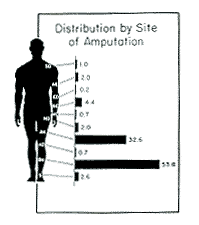 Amputations are caused by accidents, disease, and congenital disorders. Approximately 74% are due to peripheral vascular disease (poor circulation of the blood) and cancer; 23% are due to accidents, and 3% are due to a problem found at birth.
Amputations are caused by accidents, disease, and congenital disorders. Approximately 74% are due to peripheral vascular disease (poor circulation of the blood) and cancer; 23% are due to accidents, and 3% are due to a problem found at birth.
The accidents most likely to result in amputation are traffic accidents, followed by farm and industrial accidents.
Amputations in the case of disease are performed as a lifesaving measure. The diseases that cause the most amputations are peripheral vascular disease (poor circulation of the blood) and cancer.
A congenital disorder or defect of a limb present at birth is not an amputation, but rather a lack of development of part or all of a limb. A person born with a limb deficiency. usually can be helped by use of an artificial limb.
Sometimes amputation of part of a deformed limb or other surgery may be desirable before the application of an artificial limb.
There are more than 1.5 amputees per 1000 people in the United States and Canada, and therefore more than 380,000 amputees in the U.S. at the present time.
Above-knee (trans-femoral) amputees form the second largest group of amputees.
Surgeons preserve as much length in thigh amputations as is medically feasible because longer stumps provide better control over the prosthesis. Experienced surgeons avoid leaving unnecessary skin and muscle. Disarticulation at the knee preserves the entire thigh, and, in addition, permits "end-bearing", or the ability of the stump to carry a substantial portion of the body weight over the end.
The electronic version of this manual is presented by Dankmeyer, Inc., with the permission of the authors. This manual may not be redistributed in any form.